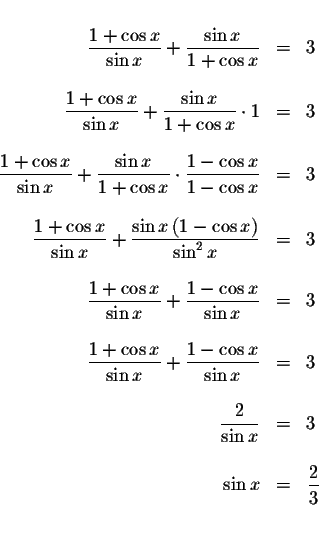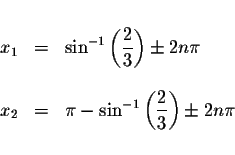
 SOLVING TRIGONOMETRIC EQUATIONS
SOLVING TRIGONOMETRIC EQUATIONS

Note: If you would like a review of trigonometry, click on trigonometry.
Example 2: Solve for x in the following equation.
There are an infinite number of solutions to this problem.
Since denominators of fractions cannot equal zero, real numbers that cause
the denominators to equal zero must be eliminated from the set of possible
solutions.
![]() and
and
![]() Therefore, before we even start
to solve the problem, the set of real numbers in the set
Therefore, before we even start
to solve the problem, the set of real numbers in the set
![]() must be excluded from the possible set of solutions.
must be excluded from the possible set of solutions.
To simplify the equation, let's multiple the second fraction by 1 in the
form
 ,
simplify and solve. The result will be an
equation that may not be equivalent to the original equation, but an
equation where we can solve for x. With this type of manipulation, there may
be extraneous answers. In other words, you may come up with answers for the
new equation that are not solutions to the original equation. Therefore,
check your answers with the original equation.
,
simplify and solve. The result will be an
equation that may not be equivalent to the original equation, but an
equation where we can solve for x. With this type of manipulation, there may
be extraneous answers. In other words, you may come up with answers for the
new equation that are not solutions to the original equation. Therefore,
check your answers with the original equation.

How do we isolate the x in this equation? We could take the arcsine of both sides of the equation. However, the sine function is not a one-to-one function.
Let's restrict the domain so the function is one-to-one on the restricted
domain while preserving the original range. The sine function is one-to-one
on the interval
![$\left[ -\displaystyle \displaystyle \frac{\pi }{2},\displaystyle \displaystyle \frac{\pi }{2}\right] .$](img8.gif) If we
restrict the domain of the sine function to that interval , we can take the
arcsine of both sides of each equation.
If we
restrict the domain of the sine function to that interval , we can take the
arcsine of both sides of each equation.

The reference angle is x. We know that
![]() Therefore, if
Therefore, if
 then
then


Since the period of ![]() equals
equals ![]() ,
these solutions will repeat
every
,
these solutions will repeat
every ![]() units. The exact solutions are
units. The exact solutions are

where n is an integer.
The approximate values of these solutions are

where n is an integer.
You can check each solution algebraically by substituting each solution in the original equation. If, after the substitution, the left side of the original equation equals the right side of the original equation, the solution is valid.
You can also check the solutions graphically by graphing the function formed by subtracting the right side of the original equation from the left side of the original equation. The solutions of the original equation are the x-intercepts of this graph.
Algebraic Check:
Check solution

Left Side:

Right Side: ![]()
Since the left side of the original equation equals the right side of the original equation when you substitute 0.7297277 for x, then 0.7297277 is a solution.
Check solution

Left Side:

Right Side: ![]()
Since the left side of the original equation equals the right side of the original equation when you substitute 2.411865 for x, then 2.411865 is a solution.
We have just verified algebraically that the exact solutions are
 and
and
 and these solutions repeat every
and these solutions repeat every ![]() units. The
approximate values of these solutions are
units. The
approximate values of these solutions are
![]() and
and ![]() 2.411865 and these solutions repeat every
2.411865 and these solutions repeat every
![]() units.
units.
Graphical Check:
Graph the function
 , formed by subtracting the right side of the original equation from the
left side of the original equation.
, formed by subtracting the right side of the original equation from the
left side of the original equation.
Note that the graph crosses the x-axis many times indicating many solutions. Let's check a few of these x-intercepts against the solutions we derived.
Verify the graph crosses the x-axis at
0.7297277. Since the period is
![]() ,
you can verify that the graph also crosses the
x-axis again at
0.7297277+6.2831853=7.012913 and at
,
you can verify that the graph also crosses the
x-axis again at
0.7297277+6.2831853=7.012913 and at
![]() ,
etc.
,
etc.
Verify the graph crosses the x-axis at 2.411865. Since the period is
![]() ,
you can verify that the graph also crosses the x-axis
again at
2.411865+6.2831853=8.69505 and at
,
you can verify that the graph also crosses the x-axis
again at
2.411865+6.2831853=8.69505 and at
![]() ,
etc.
,
etc.
Note: If the problem were to find the solutions in the interval
![]() ,
then you choose those solutions from the set of infinite
solutions that belong to the set
,
then you choose those solutions from the set of infinite
solutions that belong to the set
![]()
![]() and
and
![]()
If you would like to test yourself by working some problems similar to this example, click on Problem.
If you would like to go to the next section, click on Next.
If you would like to go back to the equation table of contents, click on Contents.

